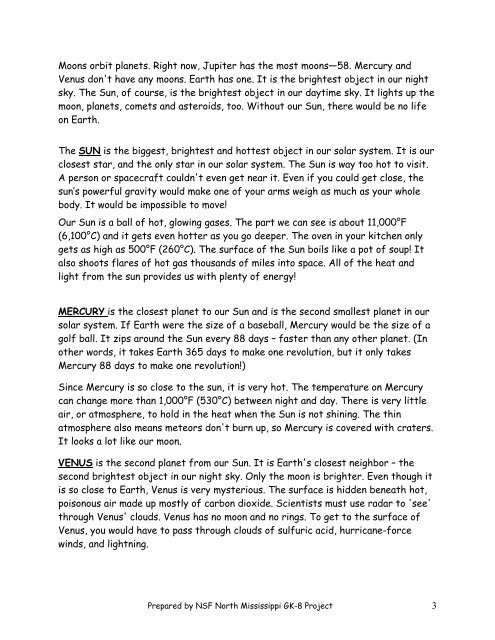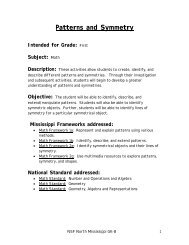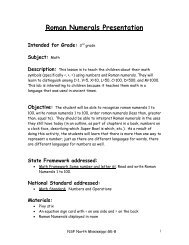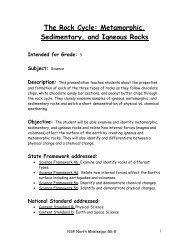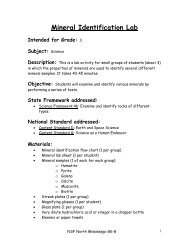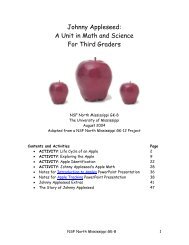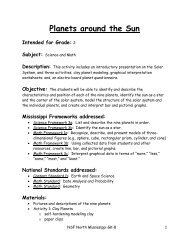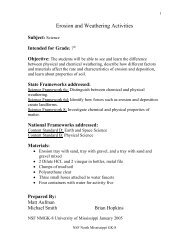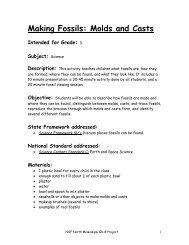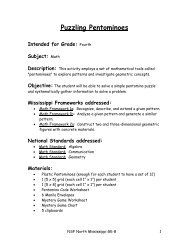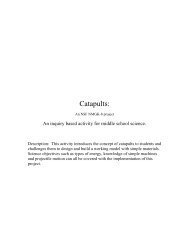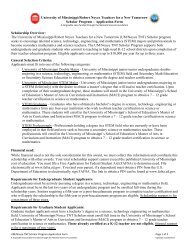GK-8 Project Submission Form - The Center for Mathematics and ...
GK-8 Project Submission Form - The Center for Mathematics and ...
GK-8 Project Submission Form - The Center for Mathematics and ...
- No tags were found...
You also want an ePaper? Increase the reach of your titles
YUMPU automatically turns print PDFs into web optimized ePapers that Google loves.
Moons orbit planets. Right now, Jupiter has the most moons—58. Mercury <strong>and</strong>Venus don't have any moons. Earth has one. It is the brightest object in our nightsky. <strong>The</strong> Sun, of course, is the brightest object in our daytime sky. It lights up themoon, planets, comets <strong>and</strong> asteroids, too. Without our Sun, there would be no lifeon Earth.<strong>The</strong> SUN is the biggest, brightest <strong>and</strong> hottest object in our solar system. It is ourclosest star, <strong>and</strong> the only star in our solar system. <strong>The</strong> Sun is way too hot to visit.A person or spacecraft couldn't even get near it. Even if you could get close, thesun’s powerful gravity would make one of your arms weigh as much as your wholebody. It would be impossible to move!Our Sun is a ball of hot, glowing gases. <strong>The</strong> part we can see is about 11,000°F(6,100°C) <strong>and</strong> it gets even hotter as you go deeper. <strong>The</strong> oven in your kitchen onlygets as high as 500°F (260°C). <strong>The</strong> surface of the Sun boils like a pot of soup! Italso shoots flares of hot gas thous<strong>and</strong>s of miles into space. All of the heat <strong>and</strong>light from the sun provides us with plenty of energy!MERCURY is the closest planet to our Sun <strong>and</strong> is the second smallest planet in oursolar system. If Earth were the size of a baseball, Mercury would be the size of agolf ball. It zips around the Sun every 88 days – faster than any other planet. (Inother words, it takes Earth 365 days to make one revolution, but it only takesMercury 88 days to make one revolution!)Since Mercury is so close to the sun, it is very hot. <strong>The</strong> temperature on Mercurycan change more than 1,000°F (530°C) between night <strong>and</strong> day. <strong>The</strong>re is very littleair, or atmosphere, to hold in the heat when the Sun is not shining. <strong>The</strong> thinatmosphere also means meteors don't burn up, so Mercury is covered with craters.It looks a lot like our moon.VENUS is the second planet from our Sun. It is Earth's closest neighbor – thesecond brightest object in our night sky. Only the moon is brighter. Even though itis so close to Earth, Venus is very mysterious. <strong>The</strong> surface is hidden beneath hot,poisonous air made up mostly of carbon dioxide. Scientists must use radar to 'see'through Venus' clouds. Venus has no moon <strong>and</strong> no rings. To get to the surface ofVenus, you would have to pass through clouds of sulfuric acid, hurricane-<strong>for</strong>cewinds, <strong>and</strong> lightning.Prepared by NSF North Mississippi <strong>GK</strong>-8 <strong>Project</strong> 3


